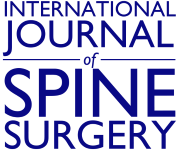Abstract
Background An abnormal postoperative lordosis distribution index (LDI), which quantifies the ratio between the lordosis at L4 to S1 and the lordosis at L1 to S1, contributes to the development of adjacent segment disease and increased revision rates in patients undergoing short-segment lumbar intervertebral fusions. Incorporating preoperative spinopelvic parameters and LDI into the surgical plan for short-segment fusion is important for guiding alignment restoration and preserving normal preoperative alignment in unfused segments. This study examined changes in LDI, segmental lordosis, and lordosis of the unfused levels in patients treated with personalized interbody cage (PIC) implants.
Methods This retrospective study evaluated radiographic measurements from 111 consecutively treated patients diagnosed with degenerative spinal conditions and treated with a short-segment fusion of L4 to L5, L5 to S1, or L4 to S1 using PIC implant(s) within 6 months of the fusion procedure. Comparisons of intervertebral lordosis for treated and untreated levels as well as LDI pre- and postoperatively were performed.
Results In patients with a preoperative hypolordotic distribution (LDI < 50%), statistically significant increases were found in LDI postoperatively, approaching the normal LDI range (LDI 50%–80%). Likewise, patients with hyperlordotic distribution preoperatively (LDI > 80%) experienced a decrease in LDI postoperatively, trending toward the normal range, although the changes were not statistically significant. Intervertebral lordosis for the L5 to S1 level increased significantly following the placement of a PIC in the normal and hypolordotic LDI groups. Changes in intervertebral lordosis for L5 to S1 were not significant for patients with preoperative hyperlordotic LDI. Reciprocal changes in intervertebral lordosis at L1 to L4 were not observed in any groups.
Conclusions PIC implants may provide a benefit for patients, particularly those with hypolordotic distributions preoperatively. They have the potential to further improve patient outcomes by helping surgeons to achieve patient-specific lordosis goals, which may help to reduce the risk of adjacent segment disease and revisions in patients undergoing short-segment lumbar intervertebral fusions.
Clinical Relevance Personalized implants can help surgeons achieve patient-specific alignment goals, potentially prevent adjacent segment disease, and reduce long-term reinterventions.
Level of Evidence 4.
- lumbar fusion
- lordosis
- personalized interbody cage
- LDI
- reciprocal changes
- adjacent segment disease
- short segment fusion
- preoperative planning
Footnotes
Funding This work was supported by funding from Carlsmed.
Declaration of Conflicting Interests Jeffrey P. Mullin discloses that he is a clinical research investigator and receives consulting fees from Carlsmed. Jahangir Asghar discloses that he is a clinical research investigator and receives consulting fees from Carlsmed. Ashvin I. Patel discloses that he receives consulting fees from Carlsmed. Joseph A. Osorio discloses that he is a clinical research investigator and receives consulting fees from Carlsmed. Justin S. Smith discloses that he is a shareholder and receives consulting fees from Carlsmed. Christopher P. Ames discloses that he is a clinical research investigator and receives consulting fees from Carlsmed. John Small discloses that he is a clinical research investigator for Carlsmed. Atman Desai discloses that he receives consulting fees from Carlsmed. Adrien Ponticorvo discloses that he is an employee of Carlsmed. Rodrigo J. Nicolau discloses that he is an employee of Carlsmed.
Disclosures In addition to the relationships listed in the Declaration of Conflicting Interests, Jeffrey Mullin reports consulting fees from Medtronic, Globus, and SI Bone, and serves on the CNS and AANS/CNS Joint Spine Section Executive Committees. Christopher Ames reports grants/contracts from SRS; royalties/licenses from DePuy Synthes, K2M, Next Orthosurgical, Stryker, Biomet Zimmer Spine, Medicrea, and NuVasive; consulting fees from DePuy Synthes, Medicrea, Agada Medical, Medtronic, and K2M; is the chair of the SRS Safety and Value Committee and serves on the executive committee of ISSG; serves on the editorial board for Operative Neurosurgery and Neurospine; is the director of Global Spinal Analytics, and has research interests with Titan Spine, ISSG, and DePuy Synthes. Justin Smith reports grants/contracts from SeaSpine/Orthofix, NREF, AO Spine, and DePuy Synthes/ISSGF; royalties/licenses from Highridge and Globus/NuVasive; consulting fees from Highridge, SeaSpine/Orthofix, Medtronic, Cerapedics, and Globus/NuVasive; support for attending meetings/travel from AO Spine; serving on the SRS Board of Directors and ISSGF Executive Committee; and stock/stock options from Alphatec and Globus/NuVasive. Altman Desai reports consulting fees from Stryker. Joseph Osorio reports grants/contracts from Medtronic; royalties/licenses from Alphatec; and consulting fees from Alphatec, Medtronic, and DePuy. John Small reports royalties/licenses from Astura Spine.
Ethics Approval This study utilized secondary research consisting of deidentified data for which consent is not required and was therefore exempt from institutional review board review under 45 CFR §46.104 (d)(4)(ii). No direct patient involvement occurred.
- This manuscript is generously published free of charge by ISASS, the International Society for the Advancement of Spine Surgery. Copyright © 2024 ISASS. To see more or order reprints or permissions, see http://ijssurgery.com.






